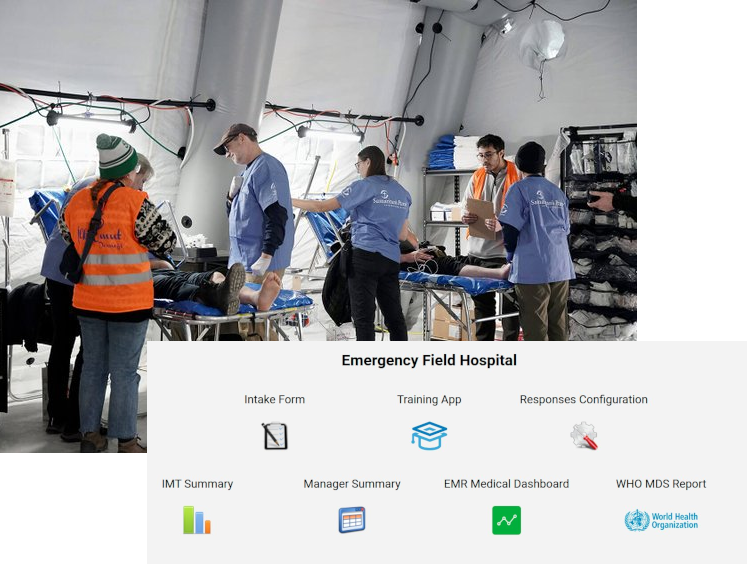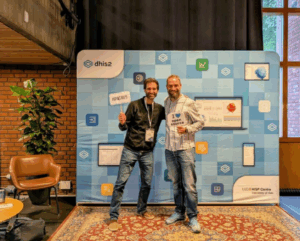Soon EyeSeeTea will be 10 years old. 10 years of developing free software for cooperation, humanitarian emergencies and research. 10 years to improve its sustainability and to work on a model that puts workers’ happiness at the center.
When we say that almost 100% of the software we develop is free software, a question is inevitably asked: how do you make money? In this article our director Ignacio Foche Pérez explains how. We also share the formulas we have tried to make EyeSeeTea a technology company where personal and professional reconciliation is possible.

Where does a company based on open source get its money from?
Unlike most large technology companies, EyeSeeTea does not sell products, does not sell code, but charges for work. Open Source does not mean free work.
The applications we make are paid for, but that doesn’t mean you have to pay to use them. For example, part of our work is to develop tools that make it easier or faster to use DHIS2, the most widely used open source health information management platform in the world. We have a suite of generic applications that help manage users of this platform, export and import data, design training modules or integrate Google Earth Engine. All these applications are free and open source, so how can it be sustainable to work on them? To a large extent, thanks to some of the clients we work for, such as various departments of the WHO or Médecins Sans Frontières. A lot of customers are using these tools and need more functionalities and improvements. And they pay for it, they pay for our ability to turn needs into functionality. And they believe, as we do, that the right thing to do is to make those functionalities available to the whole community.
In addition to these “generic” applications, we also develop ” tailor-made” applications that are adapted to the specific needs of the NGOs or departments we work with. Again, in most cases, these clients agree to release the code to make it easier, faster and more efficient to develop new applications. Finally, we don’t just make software. We also provide hosting and maintenance services for DHIS2 platforms, training, consultancy…
“We don't sell code. We charge for our work and our ability to turn needs into functionalities." Nacho Foche, Eyeseetea's founder & director

And don't others take advantage of your work?
Another common question is, “Won’t others use your work? And the answer is a resounding yes. This is the idea of taking advantage in the most positive sense of the word. Our applications are forked and replicated by other people, but we can do the same with other applications. For software that is used mostly in resource-poor countries, it is especially important that the work can be reused. We don’t want to reinvent the wheel with our code, we want the projects to be as agile as possible and to take advantage of what’s already out there, and working with free software is essential to that. It also allows customers to maintain their own applications without being tied to the developers. We have had customers who have acquired the skills to do this, and we believe that this is a positive thing, that there are more people in the community who are able to do this.
But yes, of course, there is always the risk that other people or companies will “take advantage” in a bad way. The fact that the code is open, free, probably makes it much easier for anyone to compete with you. However, at least for us, working in a niche market where knowledge of very specific technologies is required, we don’t think it’s a threat. To develop DHIS2 applications, you need a large enough team trained long enough. Also, in our case, we are fortunate enough to work in an area that is not saturated at all.
What are we most proud of?
In these 10 years, we have been able to develop emergency solutions for humanitarian situations like the war in Ukraine or the earthquake in Turkey. Delivering aid on the front line when there’s no infrastructure is a brutal benefit that you see right away, and it’s amazing to be able to contribute to that. Or developing solutions to help monitor millions of children with the new malaria vaccine, putting malaria research and treatment on the map, actively participating in solutions for neglected diseases…

We have also put DHIS2 on the map in many cases where it was not, and contributed to WHO declaring DHIS2 as the preferred health data collection system. We maintain the WHO WIDP platform, where we help 9 departments do their work in a much more efficient and coordinated way. For example, departments that raise awareness of the importance of access to universal health coverage or the fight against antimicrobial resistance.

Is it sustainable to work "for the good"?
One of the challenges of working only for the global good is making sure that we always have a sufficient number of projects to work on. So far, fortunately, this has always been the case, in part because we are not so large that we need a large volume of work. In these ten years, we have not had to lower our ethical threshold to be sustainable. We have also learned that it is important to have enough client diversification, “not to put all your eggs in one basket”.

When we combine the desire to have a positive impact with software development, we also have technological challenges.For example, we have to think about long-term maintenance, the most economical and efficient solutions to make the right use of public (or NGO) funds. Over the years we have learned that some key ideas are:
- Think generic solutions whenever possible, adapting existing ones if possible. And if they did not exist, we invented them (DHIS2 applications such as Training App, Metadata Sync…).
- Architecture concept at the heart of the projects and a commitment to “clean architecture”. It is not the fastest development in the short term, but it ensures that the software is much easier to maintain in the long term.

A model that focuses on personal work-life balance
Since its inception, EyeSeeTea has wanted to be a socially responsible company both externally and internally. Internally, this means being able to balance work and personal life with an unprecedented degree of freedom, such as being able to determine the number of hours you want to work. Often the first thing people ask us when they apply for a job with us is whether it is true that they can choose to work less than 40 hours a day. And if it is possible without being frowned upon in practice. And the answer is yes. In fact, it is a minority of people who work full days. The most common is to choose 30 hours a week, likely because it is a good compromise between more free time and less pay. And it is highly appreciated within EyeSeeTea that it is something you can adjust according to your life situation.
Of course, it’s not easy to give all employees this extra degree of freedom, because the nature of the projects may require overcapacity, which means having extra capital. At EyeSeeTea this has been “solved” for years with a very uneven burden between management and project managers and the rest of the staff. But that was a gamble that we knew had to be a temporary thing until we got to a point in the industry where we could get to a position in the industry where we could have that overcapacity. Fortunately, we are getting to that point.
We conclude with a few words from Nacho Foche, the founder and director of EyeSeeTea: “We want to make it possible to pursue happiness without it being obstructed by your work, one of the great challenges facing humanity today. Of course it’s a big challenge. We are immersed in a system that is not about optimizing happiness, but profits. That generates all kinds of challenges and tensions. We can do it partly because we are in technology, where much more capital moves than in other sectors. Many companies are still committed to optimizing the profitability paradigm. We believe that in our sector it can be done, what happens is that many times they don’t want to.”



